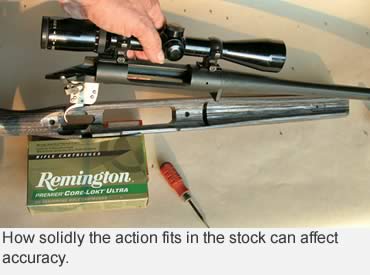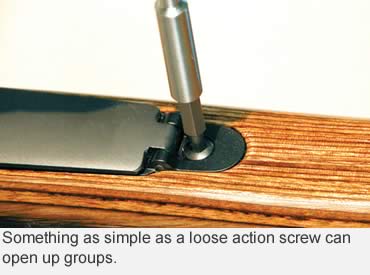Is your rifle shooting better patterns than groups? Here are the most common problems — and fixes.
Brand-new rifle. Well, it’s new to you, and a dandy — a Remington Model 700 BDL in great condition. The price was steep, but the week’s pay was worth it. Add rings, a scope, a couple of boxes of ammo, and you’re ready for the season.
When you missed the first buck at 220 yards, it was easy to blame the brush. Just a deflection. Bad luck.
But the next opportunity was harder to dismiss. Decent buck, broadside at 50 yards, oblivious to you, totally focused on a nearby doe. Using a solid rest, you put the crosshairs right on the boiler room. Squeezed the trigger firmly but smoothly, but the bullet hit him square in the paunch.
The easy lung shot would have put him down before he could exit the food plot. Instead, you spent the entire day tracking and didn’t find him until the next day.
Blaming the gun is a cop-out, but you’re as baffled as you are discouraged. Time to put this sucker on the bags and get some answers.
At the range, the breeze has died; the sight picture is steady and the rest solid. Just exhale smoothly and apply steady pressure on the trigger.
The shot felt good. It looked good. All the criteria were met — should be dead-on. Let’s check the spotting scope.
The bullet hole is at 1 o’clock and an inch outside the black. That makes for a 5-inch spread at 100 yards.
That might be all right in a pinch, if you’re looking to catch a moose in the lungs at 50 feet. But you had visions of 300-yard punchouts on whitetails.
The only way this rifle would be a threat to deer would be if a bayonet were fitted to it.
Let’s see, the gun cycles fine. It has a good scope with an adjustable objective (corrected parallax can mean up to a half-inch at 100 yards). You’ve tightened the screws on everything from the trigger guard to the scope rings.
You weren’t letting it recoil on the sling studs, were you? How about flinching? No, of course you wouldn’t do that. So let’s assume that the gun and scope are set up right and we can eliminate human variables (a big assumption). Let also assume that the load is at least in the right ballpark.
Is it a dog? A $750 tomato stake? That’s possible. Just as Detroit turns out its share of lemons, arms manufacturers and barrelmakers occasionally foul one off during mass production. And if it’s a used gun, even one with a great track record, heaven only knows how it was used or maintained.
It Can Be Fixed
We’ve established that there’s something wrong with our rifle. The good news is that everything is correctible. You’ve got to find out just how simple or expensive the correction is going to be. So where do you start?
“The first thing we look at when someone brings us a sick rifle is the condition of the bore,” says custom gunsmith Mark Bansner of Adamstown, Pa. “A good 75 to 80 percent that we encounter have never been cleaned properly.”
 Veteran benchrest shooter Joe Ventimiglia of Ohio agrees. “Whether it’s new or used, no rifle can shoot up to its potential if the bore isn’t clean,” he says.
Veteran benchrest shooter Joe Ventimiglia of Ohio agrees. “Whether it’s new or used, no rifle can shoot up to its potential if the bore isn’t clean,” he says.
Ventimiglia’s preoccupation with clean bores isn’t just benchrest nitpicking. It also stems from his position as founder and president of Ventco Industries, makers of Shooter’s Choice gun care products.
“You’ve got to realize that primer, powder and lead or copper residue build up with every shot,” he emphasizes. “If it isn’t cleaned out, that residue will be ironed into a compound that’s harder than the steel it forms on.”
That explains why benchrest shooters spend more time cleaning than they do shooting. When the bullet no longer exactly fits the muzzle portion of the bore due to residue buildup, accuracy is lost.
Whether the rifle is new or used, Ventimiglia says the remedy is to get the barrel as clean as possible, then condition the bore by shooting a round and cleaning again. Repeat the process 20 times, more if you’re determined and have the time and patience — and you’ll probably find a marked increase in accuracy. The bore will also be easier to clean in the future.
“What you’re doing is using the bullet to lap the barrel,” says Ventimiglia.
If accuracy does not improve after such conditioning, take the rifle to a gunsmith for an in-depth checkup. Chances are a practiced hand will readily spot the problem. The chamber might not be square to the bore, or maybe it’s a headspace problem.
It could also be something as simple as using the wrong bullet for your particular rifling twist rate. Or the front screw on your scope base is too long and contacts the barrel. Or the barrel isn’t screwed in tightly.
In diagnosing a sick rifle, it’s really helpful if the gun owner can bring in some fired cases, Mark Basner says. They can tell you a lot of things right away.
 “By reading the case, you can tell if the striker is hitting the firing pin in the center, or if the chamber is oversized or out of round — an indicator of extreme headspace problems.” Basner says.
“By reading the case, you can tell if the striker is hitting the firing pin in the center, or if the chamber is oversized or out of round — an indicator of extreme headspace problems.” Basner says.
A lot of accuracy problems are also solved by correcting handloads or even switching brass.
“I’ll never understand a why guy with a brand-new .243 will trot out brass he’d used in his old .243,” Bansner adds. “The new chamber is bound to be much tighter.”
A damaged crown might also be the source of inaccuracy. If the gun is used, have the crown polished while it’s in the shop. That’s just good insurance.
You might also want to ask the ’smith to check bolt clearance. Bolt-barrel interference can string shots all over the place when the barrel heats up. If the rear guard screw is too long, it can interfere with the bolt and striker, causing light hits.
None of these factors alone are likely to result in 5-inch groups, but eliminating them will certainly restore accuracy.
Bansner suggests adjusting the trigger so that it’s crisp, with no creep, as well. Nothing swells tiny groups like an 8-pound trigger. He also checks to see if the bolt face is square and laps all locking lugs for full contact. When you’re dealing with 50,000- to 60,000-psi chamber pressure, sloppy fit can send performance south in a hurry.
“You strive for 100 percent contact, but you’ll probably never get it,’’ Bansner points out. “Some factory guns come with only 30 or 40 percent contact, and that can definitely be improved. You need positive lockup — you can’t have it changing during the shot.”
You might want to have the gunsmith check firing pin protrusion (and retraction into the bold body) and pin spring tension. While spring tension shouldn’t be a problem in a recently manufactured gun, a 98 Mauser or match-grade ’03 Springfield whose tack-driving reputation is slipping might have a tension problem.
If the rifle still doesn’t shoot well, Basner looks at the bedding. The action should rest solidly on two points, with the barrel floating free of contact with the forearm.
A pillar-bedding job with either epoxy or aluminum pillars will help virtually any rifle.
“Factories like to put a third pressure point at the forearm tip of the stock,” Bansner notes. “That third point tends to dampen the vibrations in the barrel. But the only time I’ve found that to be effective is if you have a perfect barrel — the bore’s perfectly concentric with the outside.
“Free-floating allows the barrel to do its own thing. When it’s on its own, you’ll find barrel whip will be the same with every shot with a particular load.”
Remember, too, that most factory rifles are not built to shoot minute-of-angle groups. Some are, and many others have MOA potential, but a factory rifle right out of the box is built for the average hunter shooting at a relatively large target inside 100 yards.
That kind of accuracy is fine for the vast majority of shooters. But if you want better performance than that, take your gun to someone who specializes in accurizing firearms.
In rare cases, after you go through all of the metal and stock work, there’s still a chance that your gun won’t shoot. At that point, it can only be a poor barrel — usually rifling that was cut poorly or inconsistently. A new barrel will correct the problem, Basner says.
Virtually all shooting problems are solvable. It’s just that the solutions range from cleaning a barrel to replacing it — and it takes a trained eye to know the answers.
This article was published in the August 2008 edition of Buckmasters GunHunter Magazine. Subscribe today to have GunHunter delivered to your home.